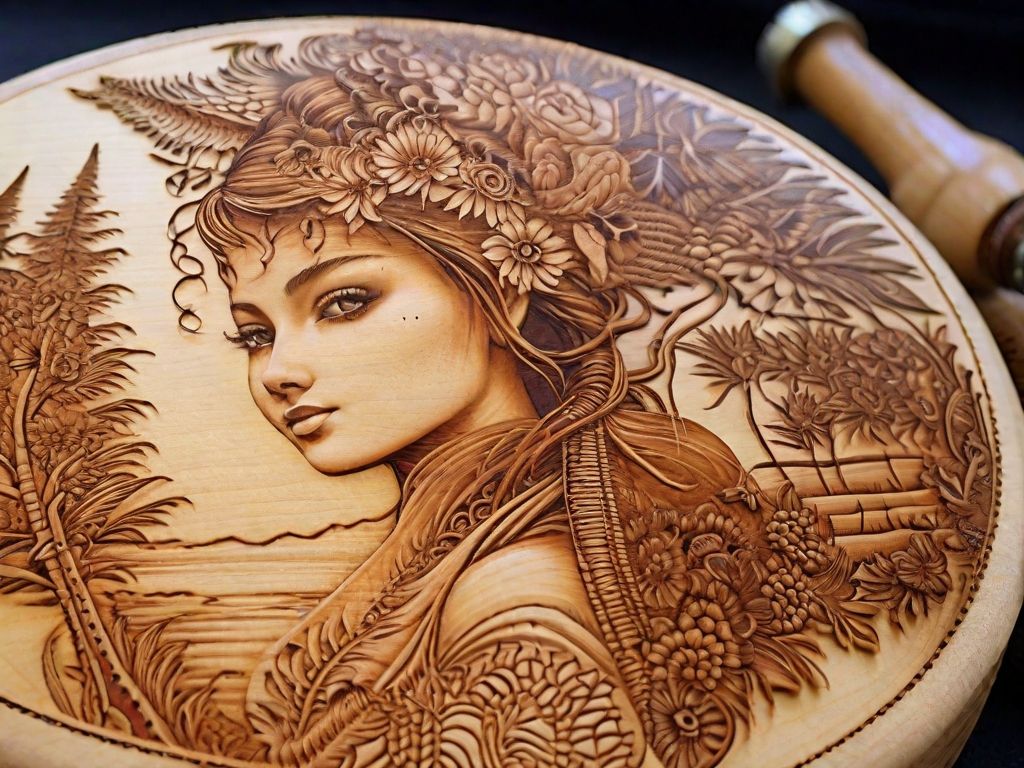A universal language of art that bridges time and geographical barriers
For centuries, artists have been finding unique and astounding ways to express themselves.
Out of these myriad art forms, one is sure to catch your eye – pyrography. Often referred to as "painting with fire".
It's an ancient technique where the artist burns or scorches designs into a piece of wood or other suitable materials. Giving it a distinctive, rustic look.
What is pyrography?
Before we dive into this amazing art form, let's take a stroll through history. To get a better grasp of the origins and development of pyrography.
Pyrography is also known as "fire writing." It's an ancient art form that has captivated the human imagination for centuries.
All around the world, cultures have used heat to create intricate designs on different surfaces. It's a fascinating practice that has left behind a tapestry of history and creativity.
A story about fire leftovers for artistic expression
The ancient art of pyrography dates back to the dawn of recorded history.
In the past, early humans, fueled by curiosity and resourcefulness, found out that fire leftovers could actually be used as a tool for artistic expression. Back in the day, they'd grab burned sticks and doodle on cave walls or wooden tools. Leaving their mark, a visual record of their existence.
As civilizations began to flourish, so did the practice of pyrography.
The Egyptians, famous for their amazing craftsmanship, embraced this art style and made it a part of their everyday lives. You can discover examples of pyrography in their tombs. Intricate designs beautifully decorate wooden furniture and burial artifacts. Revealing the skill and creativity of those talented ancient artisans.
And during the Han Dynasty of China, pyrography took on a new dimension.
People used to heat-etch materials like bamboo to record information. So, it was an early form of data recording. This application of pyrography not only kept the wisdom intact. But it also took the art to a whole new level of usefulness.
Humans always wanted to transform ordinary objects into works of art
As centuries went by, pyrography kept on evolving. Transforming into a more refined and widely embraced art form.
During the Victorian era, for example, it became a popular craft amongst gentlewomen. They would spend their leisure time burning intricate designs into various household items.
The appeal of pyrography lies in its ability to transform ordinary objects into works of art.
From decorative boxes to intricate wall hangings, pyrography offers endless possibilities for creative expression. The delicate touch of the artist's hand, guided by the heat of the tool, brings life to the wood. Creating a mesmerizing interplay of light and shadow.
In the modern age – even with all the easier artistic options available – pyrography still has its charm.
With a wide range of modern tools and techniques, it's still a popular artistic outlet for both passionate enthusiasts and professionals alike. Artists now have access to temperature-controlled pyrography pens. That offers better precision and control over the burning process. This, coupled with a wide variety of wood types and finishes, opens up endless creative possibilities.
Pyrography has even made its way into modern art galleries and exhibitions.
Artists are pushing boundaries by combining it with other mediums and experimenting with unconventional surfaces. The art form has expanded beyond traditional woodwork. It's being applied to leather, gourds, and even metal. Which showcases the versatility and adaptability of this ancient craft.
The history and evolution of this fascinating art form are proof of its lasting legacy.
From the ancient etchings of our ancestors to the awe-inspiring masterpieces of today. Pyrography keeps on fueling our imagination and making a profound mark in the art world.
So, how does pyrography actually work?
The process of pyrography is more than just an art—it's also an intriguing blend of physics and chemistry.
The friendship of fire and wood
The fundamental essence of pyrography lies in the controlled application of heat to wood. The heat source, the burn pen, works by converting electrical energy into thermal energy. Which then interacts with the wood's chemical structure to create the desired burn effect.
Getting the hang of controlling this energy transfer is super to achieve all sorts of effects in pyrographic art. Through manipulation of temperature, burn-time, and pressure, artists can create visuals ranging from soft, smoky shading to dark, deeply grooved lines.
There are also artistic techniques in pyrography
Artistic expression in pyrography is as diverse as in any other medium. Depending on the chosen technique, you can achieve effects ranging from subtle linework and stippling to bold, expressive shading.
Some artists choose to "paint" with the fire. Manipulating the tip of the burn pen much like a brush stroke to create varying tonal values. Others might use a more "drawing"-focused approach. Cutting lines into the wood for a simpler, but no less effective, effect.
What tools and materials do people use for pyrography?
Just like any art form, getting good at pyrography means you must know your tools and materials.
Traditional pyrography tools
Historically, pyrography was conducted using heated metal pokers or rods. The tips, traditionally made of brass, could be shaped or modified to create different line weights and marks.
The heat source ranged from simple embers to more sophisticated methods like heated oil. Or controlled gas flames. Such tools offered a robust and affordable way to practice this art form. But they lacked the convenience and control of modern-day equipment.
Modern pyrography equipment
Today's pyrographers have an array of advanced tools at their disposal. Modern pyrography pens sport interchangeable and customizable tips, sophisticated heat controls, and ergonomic designs. This setup brings a new level of detail and precision. Enabling the artist to truly paint with fire.
Modern materials like plywood and manufactured panels offer the artists a wider range of surfaces to work on. Experimenting with different materials can yield vastly different textures and burn qualities. Opening up new artistic possibilities.
Pyrography is a lasting testament to cultural heritage
Pyrography has come a long way since its humble beginnings.
From the ancient craftsmen of the Chinese Han Dynasty and Egypt's skilled artisans, right up to the Victorian gentlewomen and the modern artists of today, pyrography has proven to be a resilient form of artistic expression.
It stands as a lasting testament to our shared cultural heritage.
A universal language of art that bridges time and geographical barriers.
This ancient craft continues to evolve, adapt, and captivate us. Proving that the fascination of transforming simple materials into extraordinary works of art is truly an intrinsic part of our human spirit.
Pyrography, thus, serves as a vibrant thread in the rich tapestry of our shared cultural history. A thread that continues to weave inspiring tales of creativity and artistic expression to this day.





Comments ()